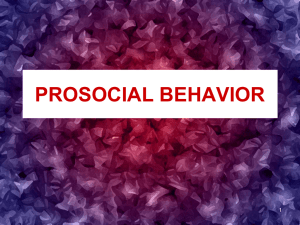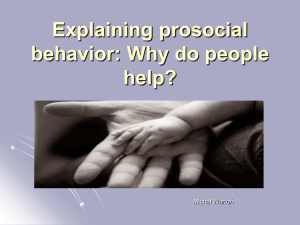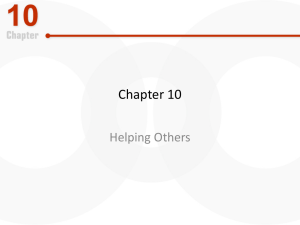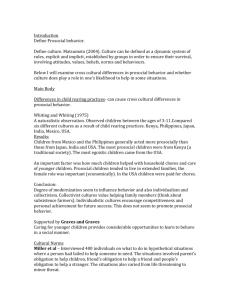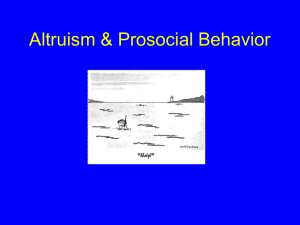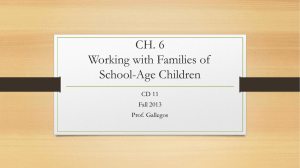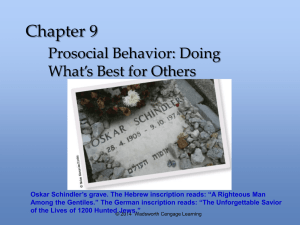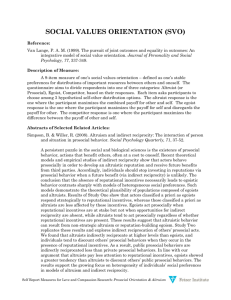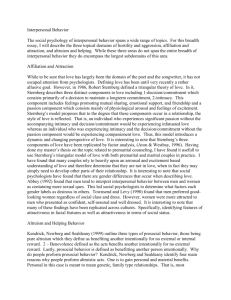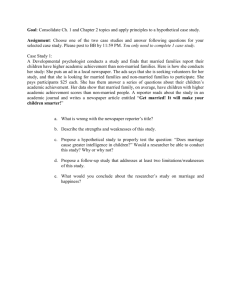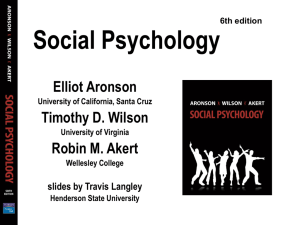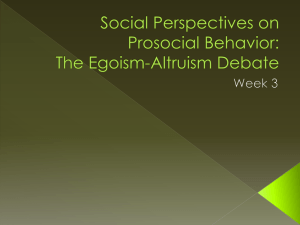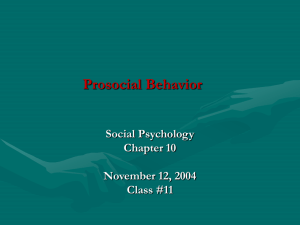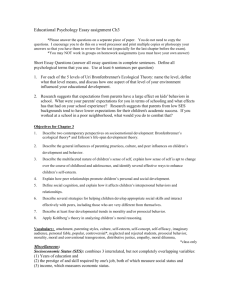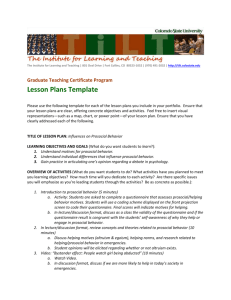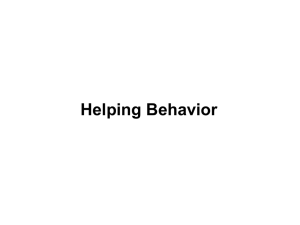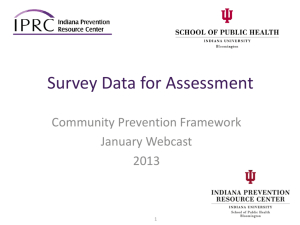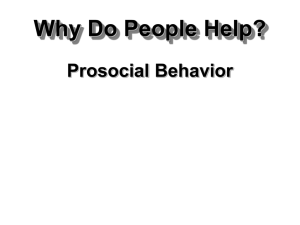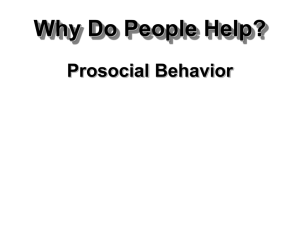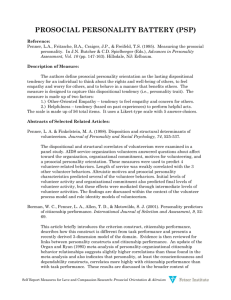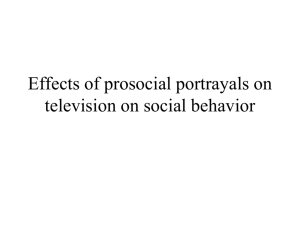Review - ThinkSpot
advertisement
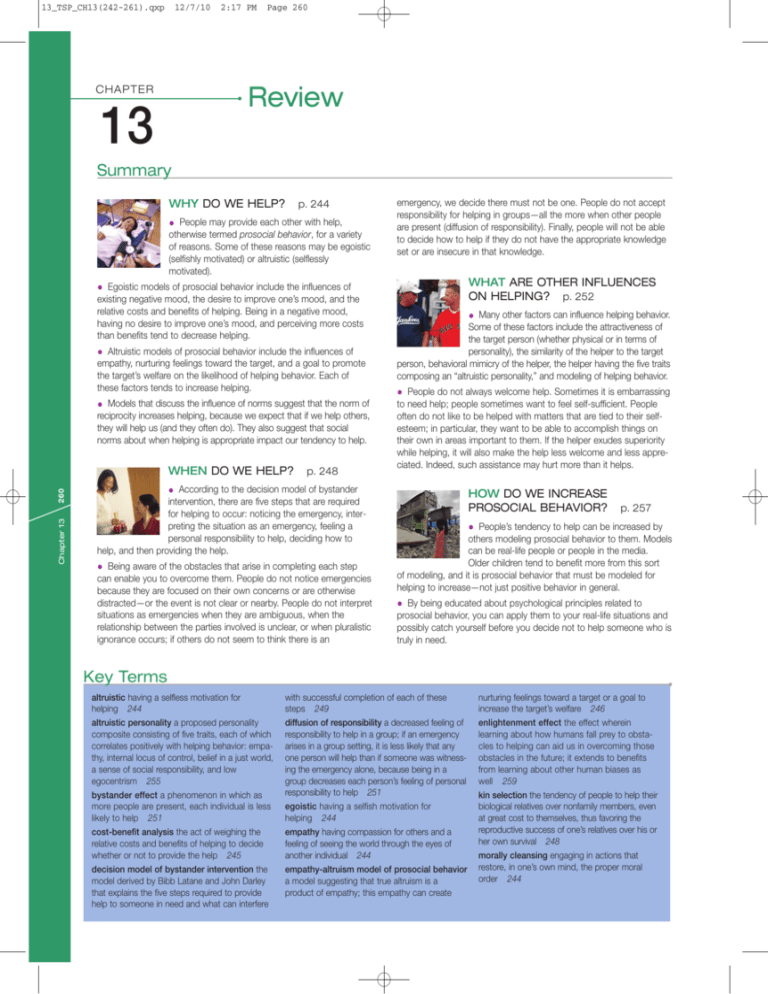
13_TSP_CH13(242-261).qxp 12/7/10 CHAPTER 2:17 PM Page 260 Review 13 Summary WHY DO WE HELP? p. 244 • People may provide each other with help, otherwise termed prosocial behavior, for a variety of reasons. Some of these reasons may be egoistic (selfishly motivated) or altruistic (selflessly motivated). emergency, we decide there must not be one. People do not accept responsibility for helping in groups—all the more when other people are present (diffusion of responsibility). Finally, people will not be able to decide how to help if they do not have the appropriate knowledge set or are insecure in that knowledge. WHAT ARE OTHER INFLUENCES ON HELPING? p. 252 • Egoistic models of prosocial behavior include the influences of existing negative mood, the desire to improve one’s mood, and the relative costs and benefits of helping. Being in a negative mood, having no desire to improve one’s mood, and perceiving more costs than benefits tend to decrease helping. • Altruistic models of prosocial behavior include the influences of empathy, nurturing feelings toward the target, and a goal to promote the target’s welfare on the likelihood of helping behavior. Each of these factors tends to increase helping. • Models that discuss the influence of norms suggest that the norm of reciprocity increases helping, because we expect that if we help others, they will help us (and they often do). They also suggest that social norms about when helping is appropriate impact our tendency to help. Chapter 13 260 WHEN DO WE HELP? p. 248 • According to the decision model of bystander intervention, there are five steps that are required for helping to occur: noticing the emergency, interpreting the situation as an emergency, feeling a personal responsibility to help, deciding how to help, and then providing the help. • Being aware of the obstacles that arise in completing each step can enable you to overcome them. People do not notice emergencies because they are focused on their own concerns or are otherwise distracted—or the event is not clear or nearby. People do not interpret situations as emergencies when they are ambiguous, when the relationship between the parties involved is unclear, or when pluralistic ignorance occurs; if others do not seem to think there is an • Many other factors can influence helping behavior. Some of these factors include the attractiveness of the target person (whether physical or in terms of personality), the similarity of the helper to the target person, behavioral mimicry of the helper, the helper having the five traits composing an “altruistic personality,” and modeling of helping behavior. • People do not always welcome help. Sometimes it is embarrassing to need help; people sometimes want to feel self-sufficient. People often do not like to be helped with matters that are tied to their selfesteem; in particular, they want to be able to accomplish things on their own in areas important to them. If the helper exudes superiority while helping, it will also make the help less welcome and less appreciated. Indeed, such assistance may hurt more than it helps. HOW DO WE INCREASE PROSOCIAL BEHAVIOR? p. 257 • People’s tendency to help can be increased by others modeling prosocial behavior to them. Models can be real-life people or people in the media. Older children tend to benefit more from this sort of modeling, and it is prosocial behavior that must be modeled for helping to increase—not just positive behavior in general. • By being educated about psychological principles related to prosocial behavior, you can apply them to your real-life situations and possibly catch yourself before you decide not to help someone who is truly in need. Key Terms altruistic having a selfless motivation for helping 244 altruistic personality a proposed personality composite consisting of five traits, each of which correlates positively with helping behavior: empathy, internal locus of control, belief in a just world, a sense of social responsibility, and low egocentrism 255 bystander effect a phenomenon in which as more people are present, each individual is less likely to help 251 cost-benefit analysis the act of weighing the relative costs and benefits of helping to decide whether or not to provide the help 245 decision model of bystander intervention the model derived by Bibb Latane and John Darley that explains the five steps required to provide help to someone in need and what can interfere with successful completion of each of these steps 249 diffusion of responsibility a decreased feeling of responsibility to help in a group; if an emergency arises in a group setting, it is less likely that any one person will help than if someone was witnessing the emergency alone, because being in a group decreases each person’s feeling of personal responsibility to help 251 egoistic having a selfish motivation for helping 244 empathy having compassion for others and a feeling of seeing the world through the eyes of another individual 244 empathy-altruism model of prosocial behavior a model suggesting that true altruism is a product of empathy; this empathy can create nurturing feelings toward a target or a goal to increase the target’s welfare 246 enlightenment effect the effect wherein learning about how humans fall prey to obstacles to helping can aid us in overcoming those obstacles in the future; it extends to benefits from learning about other human biases as well 259 kin selection the tendency of people to help their biological relatives over nonfamily members, even at great cost to themselves, thus favoring the reproductive success of one’s relatives over his or her own survival 248 morally cleansing engaging in actions that restore, in one’s own mind, the proper moral order 244 13_TSP_CH13(242-261).qxp 12/7/10 2:17 PM Page 261 negative state relief model a model positing that the reason people help others is to improve their own negative mood 244 prosocial behavior behavior designed to help another person 244 reciprocity norm the idea that if others help us, we should help them, and that if we help them, they will help us 247 social responsibility norm the idea that we have social responsibility to help others; the extent to which this extends to outgroup members varies by culture 247 Test Your Understanding MULTIPLE CHOICE 1. Charitable donations activate the same brain region that is activated when we smile. we receive a monetary reward. we eat something we like. we are praised by a classmate. a. b. c. d. 2. Which of these does not factor into a cost-benefit analysis? a. emotional harm to oneself b. someone saying “thank you” c. increased popularity from helping d. emotional harm to the target 3. Why does positive mood influence helping? a. Rewards are more accessible. b. Penalties are more accessible. c. You like the target better. d. none of these 4. In the empathy-altruism model of prosocial behavior, what him to buy your raffle tickets, he will a. buy more tickets. b. want to buy more tickets but not do it. c. offer to tell friends about the raffle. d. offer you a soda. 9. Which of these is a trait not necessarily possessed by someone with an altruistic personality? empathy social responsibility extroversion belief in a just world a. b. c. d. 10. Sometimes we don’t want to be helped. Which of these is not a reason why? The person has fewer resources than we do. Doing it on our own is important to our self-esteem. The helper exudes superiority. The person has more resources than we do. a. b. c. d. ESSAY RESPONSE 1. Consider the negative state relief model. Can we ever say for sure that this is not the cause of a given helpful behavior? What might we have to do to discount the possibility that the improvement of negative mood is the cause? 2. What does it take to help when doing so is costly to oneself? Consider the research in this chapter in your explanation. 3. The reciprocity norm was shown by infant research to be somewhat innate. What are the possible reasons for this? Consider evolutionary possibilities as well as perspectives regarding the individual’s and culture’s interests. 4. Consider why attraction might lead us to help someone whom we 6. According to the decision model of bystander intervention, why might we not notice a need for help? a. distractions b. being self-focused c. distance from event d. all of the above 7. If others do not act as though there is an emergency happening, you will interpret the event as a nonemergency. This is called diffusion of responsibility. egoism. reciprocity effect. pluralistic ignorance. a. b. c. d. are likely never to meet. Discuss any egoistic, altruistic, normative, and alternative reasons that may exist. 5. Modeling has profound effects on long- and short-term behavior. Discuss some ways in which parents can inadvertently influence their children and we can inadvertently influence our peers. APPLY IT! Think about any time you’ve been out with your friends and seen a scuffle of some sort. Maybe you saw a couple fighting outside a restaurant. Maybe you saw two men shouting about something on the street. Maybe you saw a woman striking a child, or a man dragging an animal down the street. How could you have fairly assessed whether or not there was an emergency? How could you have responded in a way that would have provided needed help to a potential victim while still ensuring your own safety? Remember to check www.thinkspot.com for additional information, downloadable flashcards, and other helpful resources. PROSOCIAL BEHAVIOR: WHY WE HELP, AND WHY WE DON’T 5. According to research, if you give someone a soda and then ask What is not something that would stop them at this stage? feeling embarrassed limited time to help having no training in how to help lack of confidence in how to help a. b. c. d. 261 promotes helping? a. similarity b. nurturing feelings c. reciprocity norm d. attraction 8. People who have decided to help must figure out how to do so. ANSWERS: 1. b; 2. d; 3. a; 4. b; 5. a; 6. d; 7. d; 8. b; 9. c; 10. a
